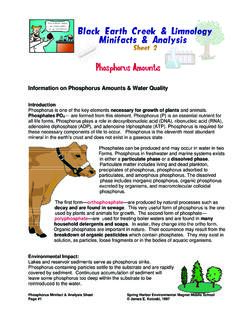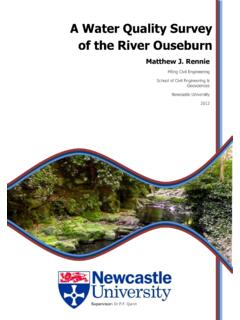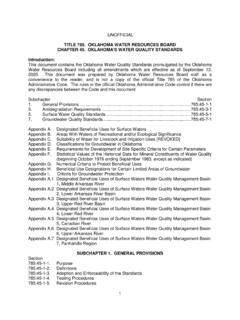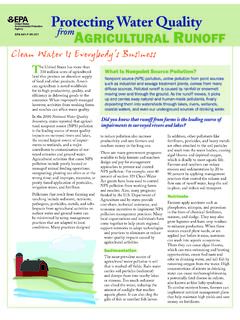Transcription of Clean Water Act: A Summary of the Law
1 Clean Water Act: A Summary of the Law Claudia Copeland Specialist in Resources and Environmental Policy October 18, 2016 Congressional Research Service 7-5700 RL30030 Clean Water Act: A Summary of the Law Congressional Research Service Summary The principal law governing pollution of the nation s surface waters is the Federal Water Pollution Control Act, or Clean Water Act. Originally enacted in 1948, it was totally revised by amendments in 1972 that gave the act its current dimensions. The 1972 legislation spelled out ambitious programs for Water quality improvement that have since been expanded and are still being implemented by industries and municipalities.
2 This report presents a Summary of the law, describing the statute without discussing its implementation. Other CRS reports discuss implementation, including CRS Report R42883, Water quality Issues in the 113th Congress: An Overview, and numerous products cited in that report. The Clean Water Act consists of two major parts, one being the provisions which authorize federal financial assistance for municipal sewage treatment plant construction. The other is the regulatory requirements that apply to industrial and municipal dischargers. The act has been termed a technology-forcing statute because of the rigorous demands placed on those who are regulated by it to achieve higher and higher levels of pollution abatement under deadlines specified in the law.
3 Early on, emphasis was on controlling discharges of conventional pollutants ( , suspended solids or bacteria that are biodegradable and occur naturally in the aquatic environment), while control of toxic pollutant discharges has been a key focus of Water quality programs more recently. Prior to 1987, programs were primarily directed at point source pollution, that is, wastes discharged by industrial and municipal facilities from discrete sources such as pipes and outfalls. Amendments to the law in that year authorized measures to address nonpoint source pollution (runoff from farm lands, forests, construction sites, and urban areas), which is estimated to represent more than 50% of the nation s remaining Water pollution problems.
4 The act also prohibits discharge of oil and hazardous substances into waters. Under this act, federal jurisdiction is broad, particularly regarding establishment of national standards or effluent limitations. Certain responsibilities are delegated to the states, and the act embodies a philosophy of federal-state partnership in which the federal government sets the agenda and standards for pollution abatement, while states carry out day-to-day activities of implementation and enforcement. To achieve its objectives, the act is based on the concept that all discharges into the nation s waters are unlawful, unless specifically authorized by a permit, which is the act s principal enforcement tool.
5 The law has civil, criminal, and administrative enforcement provisions and also permits citizen suit enforcement. Financial assistance for constructing municipal sewage treatment plants and certain other types of Water quality improvements projects is authorized under Title VI. It authorizes grants to capitalize State Water Pollution Control Revolving Funds, or loan programs. States contribute matching funds, and under the revolving loan fund concept, monies used for wastewater treatment construction are repaid to states, to be available for future construction in other communities.
6 Clean Water Act: A Summary of the Law Congressional Research Service Contents Introduction .. 1 Background .. 2 Overview .. 2 Federal and State 4 Titles II and VI Municipal Wastewater treatment Construction .. 4 Permits, Regulations, and Enforcement .. 5 Tables Table 1. Clean Water Act and Major Amendments .. 1 Table 2. Major Code Sections of the Clean Water Act .. 7 Contacts Author Contact Information .. 10 Clean Water Act: A Summary of the Law Congressional Research Service 1 Introduction The principal law governing pollution of the nation s surface waters is the Federal Water Pollution Control Act, or Clean Water Act.
7 Originally enacted in 1948, it was totally revised by amendments in 1972 that gave the act its current shape. The 1972 legislation spelled out ambitious programs for Water quality improvement that have since been expanded and are still being implemented by industries, municipalities, and others. Congress made fine-tuning amendments in 1977, revised portions of the law in 1981, and enacted further amendments in 1987 and 2014. This report presents a Summary of the law, describing the statute. It is excerpted from a larger document, CRS Report RL30798, Environmental Laws: Summaries of Major Statutes Administered by the Environmental Protection Agency.
8 Many details and secondary provisions are omitted here, and even some major components are only briefly mentioned. Further, this report describes the statute, while other CRS products discuss implementation Table 1 shows the original enactment and subsequent major amendments. Table 2, at the end of this report, cites the major Code sections of the codified statute. Table 1. Clean Water Act and Major Amendments (codified generally as 33 1251-1387) Year Act Public Law 1948 Federal Water Pollution Control Act 80-845 (Act of June 30, 1948) 1956 Water Pollution Control Act of 1956 84-660 (Act of July 9, 1956)
9 1961 Federal Water Pollution Control Act Amendments 87-88 1965 Water quality Act of 1965 89-234 1966 Clean Water Restoration Act 89-753 1970 Water quality Improvement Act of 1970 91-224, Part I 1972 Federal Water Pollution Control Act Amendments 92-500 1977 Clean Water Act of 1977 95-217 1981 Municipal Wastewater treatment Construction Grants Amendments 97-117 1987 Water quality Act of 1987 100-4 2014 Water Resources Reform and Development Act of 2014 (Title V) 113-121 Authorizations for appropriations to support the law generally expired at the end of FY1990 (September 30, 1990).
10 Programs did not lapse, however, and Congress has continued to appropriate funds to carry out the act. Since the 1987 amendments, although Congress has enacted several bills that reauthorize and modify a number of individual provisions in the law, none comprehensively addressed major programs or requirements. 1 For example, CRS Report R43867, Water quality Issues in the 114th Congress: An Overview. Clean Water Act: A Summary of the Law Congressional Research Service 2 Background The Federal Water Pollution Control Act of 1948 was the first comprehensive statement of federal interest in Clean Water programs, and it specifically provided state and local governments with technical assistance funds to address Water pollution problems, including research.


















